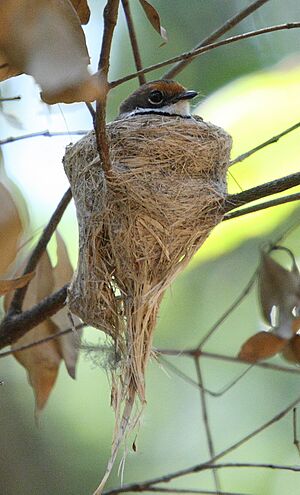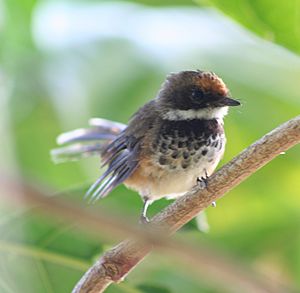Australian rufous fantail facts for kids
Quick facts for kids Australian rufous fantail |
|
|---|---|
 |
|
| Adult | |
| Conservation status | |
| Scientific classification | |
| Genus: |
Rhipidura
|
| Species: |
rufifrons
|
The Australian rufous fantail (Rhipidura rufifrons) is a small, active bird found in Australia and parts of Asia. It's also known as the rufous-fronted fantail. This bird is easy to spot because of its bright orange-reddish-brown back, rump (the area above its tail), and the base of its tail. It also has a black and white chest that fades into a white chin and throat.
These fantails are known for being very busy birds! They fly short distances often and might even hop around on leaves or the ground while looking for food. They mostly eat small insects found in the lower parts of trees.
Australian rufous fantails are also migratory birds. This means they travel long distances. They fly to south-eastern Australia in the spring to have their babies, and then head north in the autumn. Even though their numbers might be going down a little, they are found over a very large area. Because of this, experts consider them a species of least concern, meaning they are not currently in danger of disappearing.
Contents
What's in a Name?
Birds often have scientific names that tell us something about them. The Australian rufous fantail's scientific name is Rhipidura rufifrons.
How Did It Get Its Name?
The Australian rufous fantail was first described by a scientist named Latham in 1801. He first called it Muscicapa rufifrons. Later, other scientists, Vigors and Horsfield, moved it to the group (genus) called Rhipidura.
The name Rhipidura comes from two ancient Greek words: rhipido, which means "fan-like," and oura, meaning "tail." This makes sense because these birds often fan out their tails! The second part of its name, rufifrons, comes from two Latin words: rufus, meaning "red," and frons, meaning "forehead." So, its name basically means "red-foreheaded fan-tail"!
Other Names for This Bird
The Australian rufous fantail has many other common English names. Some people call it the rufous-fronted fantail, wood fantail, red fantail, or even red fan.
Family Tree: Related Birds
The Australian rufous fantail is one of more than 40 species in the Rhipidura group, which are all known as fantails. It's closely related to five other fantail species, including the Arafura fantail (Rhipidura dryas). These birds are so similar that sometimes they are even considered the same species!
What Does the Rufous Fantail Look Like?
These are medium-sized birds. They are usually about 14.5 to 18.5 centimeters (about 6 to 7 inches) long, which is about the length of a pen. Their wings can spread out to about 18 to 22.5 centimeters (about 7 to 9 inches) wide. They are very light, weighing only about 10 grams, which is less than a handful of coins! Both male and female fantails look the same, though females are usually a bit smaller.
Let's look at their colors:
- Head: Their forehead is a rich reddish-brown color, and they have a white arc just below their eyes. The top of their head, back of their neck, and upper back are olive to reddish-brown.
- Tail: This color blends into a blackish-brown, long, fan-shaped tail. The base of their tail has a lighter tip, often white.
- Face: They have black feathers over their ears, just below and behind their eyes.
- Body: Their throat is white, and they have a black band across their upper chest. Below this, their lower chest is off-white with black, scale-like spots. This fades into an off-white color towards the middle of their belly.
- Eyes, Bill, and Feet: Their eyes, beak, and feet are all brown.
These colors stay the same throughout the year. Young fantails look similar to adults, but their colors are a bit duller. Their tails and undersides are slightly browner, and the base of their beak and legs are a lighter brown.
What Sounds Do They Make?
Australian rufous fantails make several different sounds, like chips, buzzes, and scolds. Their "chip call" is often the first thing people notice about them. It's a high-pitched sound with two quick chip noises. They make this call when they are looking for food, defending their territory, or warning others about a predator. They also sing after sunset, sometimes to attract a mate.
Birds That Look Similar
The Australian rufous fantail is similar in size and shape to the grey fantail (Rhipidura albiscapa). However, the rufous fantail has a slightly larger fanned tail and makes higher-pitched, softer songs.
You can easily tell the Australian rufous fantail apart by its orange-reddish-brown back, rump, and tail base. Also, they tend to look for food in shady, moist areas close to the ground, which helps distinguish them from other fantails.
Where Do They Live?
Their Home Range
The Australian rufous fantail can be found in parts of Australia, Southeast Asia, and islands in Micronesia and Melanesia. They live in the Lesser Sunda Islands and the Maluku Islands of Indonesia, southern New Guinea and its nearby islands, the Solomon Islands, the Marianas, and the island of Yap in the Carolinian Islands. In Australia, you can find them along the northern and eastern coasts.
Their Favorite Places to Live
Australian rufous fantails like moist and somewhat dense places. They can live in many different types of habitats, including eucalyptus forests, mangroves, rainforests, and woodlands (especially near rivers or swamps). Sometimes, they are even found in dry sclerophyll forests. Basically, they can live in almost any landscape in the Australo-Papuan region, except for open grasslands or very dry areas.
These birds usually stay in the lower parts of their habitat, like the undergrowth or just below the main tree canopy. They rarely go higher than 6 meters (about 20 feet) off the ground.
How Do They Behave?
Australian rufous fantails are often described as very active birds. They are almost always moving, fidgeting, and waving their fanned-out tails. They are usually seen flitting around in the lower parts of their habitat, staying close to the shade. They make short, frequent flights, stopping briefly to perch, and sometimes hopping between leaves or onto the ground.
Having Babies
You'll usually see these birds alone or in pairs. They build their nests in pairs and are thought to stay with the same mate. Males sing to protect their territory and attract a female. Sometimes, this leads to long and fast "singing battles" between males!
Once a pair forms, both birds look for a good place to build a nest, but the female makes the final decision. Males have even been seen feeding their female partners for a few weeks before and during the nest-building process. They prefer to build nests in rainforests or sheltered, humid areas with lots of dense trees, shrubs, and vines. The nest is usually built in the fork of two almost horizontal tree branches, often near water like a stream. Their nests are shaped like a wine glass with a broken bottom. They build their nests, usually in November, December, and January, using thin strips of tree bark, grass, moss, and decayed wood.
The eggs are round or oval, sometimes pointed at one end. They are usually a pale cream to yellowish-white color with light brown and purplish marks or spots. A nest typically has 3 or 4 eggs.
Both parents help care for the young. They take turns feeding their nestlings and cleaning the nest by removing waste. While only females have been seen sitting on the eggs to keep them warm (incubating), it's thought that males might do this too.
Young fantails leave the nest about four to five weeks after hatching. They stay near their birth area until they make their first long migration.
Their Big Journey: Migration
Most Australian rufous fantails are strong migrants. This means they use the same travel route every year and leave and arrive at regular times. They fly to south-eastern Australia in the spring to breed, starting in September and peaking in October. Then, they fly north in the autumn, usually in March and April.
What Do They Eat?
They mostly eat small insects. They often join groups of other small birds, like the spectacled monarch or the little shrikethrush, to find food.
The Australian rufous fantail usually catches its prey while flying. They move almost constantly through and between plants. They stop (perch) for very short times, fanning their tails. Sometimes, they perch a bit longer to look around.
Once they spot an insect, they chase it with incredibly quick and agile flights through the trees. They can also hover to pick insects off leaves, and sometimes even from the ground or fallen debris. They have longer legs than other fantail species, which helps them move easily on the ground too.
Who Are Their Predators?
Many eggs and young fantails are lost to a bird called the pied currawong (Strepera graculina), which is thought to be a main predator.
How Humans Affect Them
When forests are logged (trees are cut down), it can change where the fantails look for food. They might move from the forest floor to the lower parts of the trees. However, they prefer forests that haven't been disturbed by logging. Logging can reduce the places where they can breed and increase the risk of their habitats being broken up, especially if these forests are along their migration routes.
Are They in Danger?
The Australian rufous fantail lives over a very large area. Because their range is so big, they are not considered vulnerable (which means their population is not small enough to be at high risk). Even though their population size hasn't been fully measured, it's thought to be slowly declining. However, it's not declining fast enough to put them in a vulnerable status. Therefore, the IUCN (International Union for Conservation of Nature) classifies them as a species of least concern.
See also
 In Spanish: Abanico rojizo para niños
In Spanish: Abanico rojizo para niños





